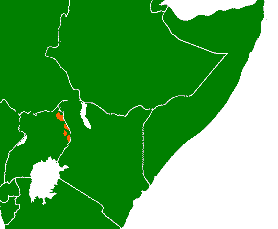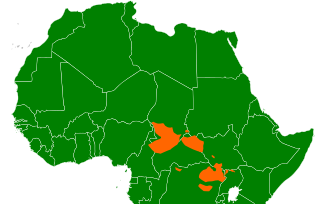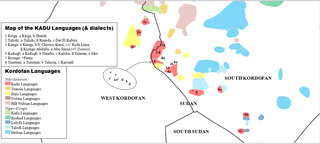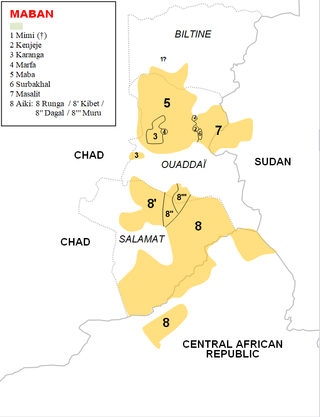| Classification | Language | 1 | 2 | 3 | 4 | 5 | 6 | 7 | 8 | 9 | 10 |
|---|
| Eastern, Bari | Bari | ɡɛ́lɛ̀ŋ | mʊ̀rɛ́k | mʊ̀sálà | ɪ́ŋwàn | mʊ̀kánàt | búkɛ̀r | búryò | búdö̀k | bʊ́ŋwàn | púwö̀k |
| Eastern, Lotuxo-Teso, Lotuxo-Maa, Lotuxo | Lopit | F/ M nàbóìtóì / lòbóìtóì | lòhórìk, arik | lòhúnìk | lóŋwán | mìyét (litː < 'hand') | ile | hatarik (5 + 2) | hotohunɪk (5 + 3) | hotoŋwan (5 + 4) | tomon |
| Eastern, Lotuxo-Teso, Lotuxo-Maa, Lotuxo | Lotuho (Lotuxo) (1) | ábótè | áréhè | húníhe | áŋwàn | mìyyàt (litː < 'hand') | ɪ́lle | hàtmɪk (5 + 2) | hùtohunɪk (5 + 3) | hùtoŋwan (5 + 4) | tòmmòn |
| Eastern, Lotuxo-Teso, Lotuxo-Maa, Lotuxo | Lotuho (Lotuxo) (2) | ʌ̀bóíté / âbotye | ʌ̀ríxèy / árrexai | xúnixòì / xunixoi | aŋwân | míèt < 'hand' | ɪ́llɛ́ | xáttàrɪ̀k (5 + 2) | xóttóxúnìk (5 + 3) | xɔ́ttɔ́ŋwàn (5 + 4) | tɔ́mɔ̀n |
| Eastern, Lotuxo-Teso, Lotuxo-Maa, Ongamo-Maa | Maasai | nabô (fem), obô (masc), nebô (place) | aré (fem), aàre/ɔáre (masc) | uní (fem), okúni (masc) | oŋwán (fem), oóŋwan (masc) | ímíêt | ílɛ̂ / íllɛ̂ | naápishana (f.), oópishana (m.) | ísíêt < Kalenjin | naáudo (fem), oódó (masc) | tɔ́mɔ̂n < Kalenjin |
| Eastern, Lotuxo-Teso, Lotuxo-Maa, Ongamo-Maa | Samburu | naɓô (fem), oɓô (masc), noɓô (place) | aré (fem), waáre (masc) | uní (fem), okúni (masc) | onɠwán (fem), oónɠwan (masc) | ímɟêt / ímʄêt | ílê | sápâ | ísɟêt / ísʄêt < Kalenjin | sâːl | tômôn < Kalenjin |
| Eastern, Lotuxo-Teso, Teso-Turkana, Teso | Teso (Ateso) (1) | ìdʸòpét | ìɑɾè | íwúní | íwóŋón | íkɑ̀ɲ | íkɑ̀ɲɑ̂pè (5 + 1) | íkɑ̀ɲɑ̂ɾè (5 + 2) | íkɑ̀ɲɑ̂wùní (5 + 3) | íkɑ̀ɲɑ̂wòŋòn (5 + 4) | ítòmòn |
| Eastern, Lotuxo-Teso, Teso-Turkana, Teso | Teso (Ateso) (2) | -diope | -árèy | -(w)únì | -oŋôn | -kaɲ < 'hand' | kaɲ kape (5 + 1) | kaɲ karey (5 + 2) | kaɲ kauni (5 + 3) | kaɲ kaoŋon (5 + 4) | tɔ́mɔ̀n |
| Eastern, Lotuxo-Teso, Teso-Turkana, Turkana | Karamojong (Dodotho) (1) | ɲípéí | ŋíááréí | ŋúúní | ŋóómwán | ŋííkan (< hand) | ŋíkan ka péí (5 + 1) | ŋíkan ka áréí (5 + 2) | ŋíkan ka úní (5 + 3) | ŋíkan ko ómwán (5 + 4) | ŋítomón |
| Eastern, Lotuxo-Teso, Teso-Turkana, Turkana | Karamojong (2) | ɛpei | ŋiarei | ŋiuni | ŋiomwɔn | ŋikan < hand | ŋíkàn kà-pei (5 + 1) | ŋíkàn kà-arei (5 + 2) | ŋíkàn kà-uni (5 + 3) | ŋíkàn kà-omwɔn (5 + 4) | ŋítɔ̀mɔ́n |
| Eastern, Lotuxo-Teso, Teso-Turkana, Turkana | Nyangatom | a-péy ̀ | ŋa-áréy ̀ | ŋa-uní ̀ | ŋa-omwɔn ̀ | ŋa-kànɪ (litː hand) | ŋa-kanɪ̀ ka-pey (5 + 1) | ŋa-kanɪ̀ ka-arey (5 + 2) | ŋa-kanɪ ka-uni (5 + 3) | ŋa-kanɪ ka-omwɔn (5 + 4) | ŋa-tɔ̀mɔn |
| Eastern, Lotuxo-Teso, Teso-Turkana, Turkana | Toposa | péì | áréì | ʊ́nì | ɔ́ŋwɔ́n | kànì̥ < hand | kànì̥ kà-péì (5 + 1) | kànì̥ kà-àréì (5 + 2) | kànì̥ kà-ʊ́ní (5 + 3) | kànì̥ kà-ɔ́ŋwɔ́n (5 + 4) | tɔ̀mɔ́ní̥ |
| Eastern, Lotuxo-Teso, Teso-Turkana, Turkana | Turkana | a-péy ̀ | ŋa-áréy ̀ | ŋa-úní ̀ | ŋa-ómwɔ̀n ̀ | ŋa-kànɪ̥ < hand | ŋa-kanɪ ka-péy (5 + 1) | ŋa-kanɪ ka-áréy (5 + 2) | ŋa-kanɪ ka-úní (5 + 3) | ŋa-kanɪ ka-ómwɔ̀n (5 + 4) | ŋa-tɔ̀mɔn |
| Southern, Kalenjin, Elgon | Kupsabiny (Sebei) | aɡeenɡe [akɛ́ːŋkɛ] | äyëëny [ɑréːɲ] | sömök [sómok] | anɡʼwan [aŋwán] | müüt [múːt] | müüt äk aɡeenɡe [múːt ɑk akɛ́ːŋkɛ] | müüt äk äyëëny (5 + 2) | müüt äk sömök (5 + 3) | müüt äk anɡʼwan (5 + 4) | taman [támán] |
| Southern, Kalenjin, Elgon | Sabaot (Koony dialect) | akeenke [ aɡɛ́ːŋɡɛ] | āyēēnɡʼ [ɑyéːŋ] | sōmōk [sómok] | anɡʼwan [aŋwán] | mūūt / muut [múːt] | lo [lɑ] | tisab [tɪ́sap] | sisiit [sɪsɪ́ːt] | sokool [sɑ́kɑːl] | taman [támán] |
| Southern, Kalenjin, Nandi-Markweta, Markweta | Cherang'any | àkɛ́ɛ́ŋkɛ̀ | ʌ́yíín | sómòk | áŋwaan | múút | lɔ̀ | tɪsáp | sìsít | sʌ́ɡʌ́l | támán |
| Southern, Kalenjin, Nandi-Markweta, Markweta | Endo (Marakwet) | ɒ́kɔ́ːŋɔ | ərèːɲ | sómók | ɒ́ŋwɒ̀n | mùːt | lɔ́ | tɪ́sɔ́p | sisíːt | sɔkɔ̀ːl | tɒmɒn |
| Southern, Kalenjin, Nandi-Markweta, Nandi | Keiyo | àkɛ́ŋɡɛ̂ / àɛ́ŋɡɛ̂ | aɛ́ːŋ /aɛ́ːɲ | sɔ̀mɔ̂k | àŋwàn | mʊ́ːt | lɔ̂ | tɪ̀sâp | sɪ̀sɪ́ːt | sɔ́kɔ́ːl | támán |
| Southern, Kalenjin, Nandi-Markweta, Nandi | Tugen | àɣééɲɡé | àééɲ | sómók | àɲwán | múút | ló | tísáp | sìsíít | sóɣóòl | tàmán |
| Southern, Kalenjin, Okiek | Akie (Okiek) | akɛɛnkɛ | ayen | somok | aŋwàn | mʊ́ʊ́t | ílɛ | nápíʃana | ísíêt | náúdo | taman |
| Southern, Kalenjin, Pokot | Pökoot (Suk) | àkɔ́ɔ́ŋkɔ̀ | oɣë̀ë̀ŋ / òdë̀ë̀ŋ | sä́mä́k | àŋwân | múut | múut ŋɡɔ́ àkɔ́ɔ́ŋɔ̀ (5 + 1) | múut ŋɡɔ́ òdë̀ë̀ŋ (5 + 2) | múut ŋɡɔ́ sä́mä́k (5 + 3) | múut ŋɡɔ́ àŋwân (5 + 4) | támàn |
| Southern, Tatoga | Asimjeeg Datooga (1) | àkàlɛːlɛ̀ː / ák / (àqàlɛːlɛ̀ː) | íjèɲ | sàmòɡw | àŋwàn | mùːt | lá | ísːpò | sìs | ʃàɡàʃ | dàmàn |
| Southern, Tatoga | Datooga (2) | ɑ̀ɡi | íiyèeɲɑ | sɑ́mɑ̀ɡu | ɑ́ŋwɑ́n | mʊ̀ʊt | lɑ́ | íispɑ̀ | sís | ʃɑ́ɡɛ̀ɛʃ | dɑ̀mɑ́nɑ́mʊ́qʊ̀ʊʃ |
| Southern, Tatoga | Datooga (3) | ʔàɡi | íyèeɲa | sàmàɡu | ʔàŋwàn | mùuti ~ bánàakta mùuti | làh | ìsbà ~ isbwà | sìss ~ sìs | ʃàɡèeʃʃ ~ ʃàɡèeʃ | dàmáná múqùuʃ |
| Western, Dinka-Nuer, Dinka | Dinka Agaar | ʈɔ́k | rɔ́ʷ | dʲák | ŋʊ̀ʷân | ðíɟ | ðɛ̀ʈem | ðɜ̀rʊ́ʷ | bɛ̀ʈ | ðɔ̀ŋʊ́ʷàn | t̪íʲàːr |
| Western, Dinka-Nuer, Dinka | Dinka Padang | tò̤k | ròw | dyá̤k | ŋwán | d̪yì̤c | d̪ètém | d̪ɔ̀rɔ́w | bɛ̤́t | d̪ɔ̀ŋwán | t̪yɛ́ɛ̀r |
| Western, Dinka-Nuer, Nuer | Nuer (1) | kɛ̀ːl | rɜ̀ʷ | dɪʲɔ̂k | ŋʊ́ʷǎn | ðɪ́ʲɛ̀ɟ | bakɛ̀l (5 + 1) | bàraʷ (5 + 2) | bɛ̀dak (5 + 3) | bɜ̀ŋʊ́ʷǎn (5 + 4) | wɜ́ːl |
| Western, Dinka-Nuer, Nuer | Nuer (2) | kɛ́ɛ̀l | rɛ̌w | dyɔ̌k | ŋwán | d̪yè̤c | bʌ̤́kɛ̀l (5 + 1) | bʌ̤rɔ̀w (5 + 2) | bʌ̤̀dá̤k (5 + 3) | bʌ̤́ŋwàn (5 + 4) | wá̤l |
| Western, Luo, Northern, Anuak | Anuak(Anyua) (1) | àcíɛ̀l | àríyɔ̀ | àdʌ́k | àŋwɛ́ɛ́n | àbíc | àbícìɛ̀l (5+ 1) | àbíríyɔ̀ (5+ 2) | àbárà (5+ 3) | àbíŋwɛ̀ɛ̀n (5+ 4) | àpár |
| Western, Luo, Northern, Anuak | Anuak (2) | aciel / acíɛ̀l | ariio̤ / aríɪàw | ada̤k / adʌ́ɡ | aŋween / aŋwɛ́ɛn | abi̤i̤c / abíiɟ | abi̤ciel / abícíɛ̀l (5+ 1) | abi̤riio̤ /abíríɪàw (5+ 2) | aba̤ra / abʌ́rʌ́ (5+ 3) | abi̤ŋween / abíŋwɛ̀ɛn (5+ 4) | apaar / apáar |
| Western, Luo, Northern, Bor | Belanda Bor | ákɛɛ̂l | arɛ̂w | àdéɡ | àŋwɛ́n | àbíc | àbíc kúkɛ́l (5+ 1) | àbíc kúrɛ̂w (5+ 2) | àbíc kùdēēk (5+ 3) | àbíc kúŋwɛ̂n (5+ 4) | áfaàr |
| Western, Luo, Northern, Jur | Luwo | áciɛ̄lɔ́ | á̟riɔ̄w | á̟dá̟ɡ | áŋwɛ̄ːn | àbī̟ːj | ábíciɛ̄l (5 + 1) | ábɛ́riɔ̄w (5 + 2) | á̟bɛ̟́dā̟ɡ (5 + 3) | ábɛ́ŋwɛ̄ːn (5 + 4) | āpāːr |
| Western, Luo, Northern, Mabaan-Burun, Burun | Burun (Mayak) | kɛɛl / kɛ̀ɛl | rɛɛ / rɛ̄ | ɖʌk /ɖʌ̄k | ŋan / ŋān | d̪oc / dōoc | ɖowk /ɖɔ́ùk | ŋat̪ukɛl / ŋàtúkɛ́l | ŋunu / ŋɔ̀nʊ́ | ɟucukɛl / ɲùcúkɛ́l | caac / cáac |
| Western, Luo, Northern, Mabaan-Burun, Mabaan | Mabaan | cyɛ́ɛlɔ̀ | yɛ́ɛwɔ̀ | ɗɔ́ɔ́ɡɔ́ | ŋáánɔ̀ | d̪ɔ́ɔ́yɔ̀ | d̪ɔ́ɔ́yɔ̀ wílin nè cyɛ́ɛlɔ̀ (5 + 1) | d̪ɔ́ɔ́yɔ̀ wítkɛ̀n nè yɛ́ɛwɔ̀ (5 + 2) | d̪ɔ́ɔ́yɔ̀ wítkɛ̀n nè ɗɔ́ɔ́ɡɔ́ (5 + 3) | d̪ɔ́ɔ́yɔ̀ wítkɛ̀n nè ŋáánɔ̀ (5 + 4) | ínyáákkɛ̀n (lit: both hands) |
| Western, Luo, Northern, Shilluk | Shilluk | àkjɛ̀l | áɾjɛ̀w | ádə̀k | áŋwɛ̀n | ábîc | ábîkjɛ̀l (5 + 1) | abìɾjɛ̀w (5 + 2) | àbîdèk (5 + 3) | ábîŋwɛ̀n (5 + 4) | pjáár |
| Western, Luo, Northern, Thuri | Thuri | ácîel | aríòw | ádeèk | àŋwɛɛ̀n | àbííc | abícbícèl (5+ 1) | àbícbə́riə́ɔ̀w (5+ 2) | àbícbídèk (5+ 3) | àbíc bə́ŋwɛ́ɛn (5+ 4) | ápaàr |
| Western, Luo, Northern, Unclassified | Päri (Lokoro) (1) | ácɛ̀lɔ́ | árìyɔ́ | ádòɡó | áŋwɛ̀nɔ́ | ábìd͡ʒɔ́ | àbícɛ̀lɔ́ (5+ 1) | àbírìyɔ́ (5+ 2) | ábʌ̄rà (5+ 3) | ábúŋwɛ̀nɔ́ (5+ 4) | ápàr |
| Western, Luo, Northern, Unclassified | Päri (Lokoro) (2) | acyelo, took | aryo, ireek | adöɡo, ɡala | aŋweno | abijo, kunat | abicyelo (5+ 1), bukel | abiryo (5+ 2), buryo | abidö̈ɡo, aböra (5+ 3), bodök | abuŋweno (5+ 4), buŋwan | apar |
| Western, Luo, Southern, Adhola | Adhola (1) | ɑ́cêr | ɑ́rîo | ɑ́dêːk | ɑ́ŋʷên | ɑ́bîːc | ɑ̀ᵘcèr (5+ 1) | ɑ̀bírîo (5+ 2) | ɑ́bôːrò (5+ 3) | ɑ̀búŋʷèn (5+ 4) | ɑ́pɑ̂ːr |
| Western, Luo, Southern, Adhola | Adhola (2) | àcíɛl | àríó | àdeék | àŋwɛɛ̂n | àbîc | àwúciɛ̄l (5+ 1) | àbíirò (5+ 2) | àbɔ́ɔ̀rò (5+ 3) | àbúŋwɛ́n (5+ 4) | ápāar |
| Western, Luo, Southern, Kumam | Kumam | ɑ̀cɛ́l | ɑ̀ré | ɑ̀dēk | òŋwɔ́n | kɑ̄ɲ | kɑ́ɲ ɑ̀pé (5 + 1) | kɑ̄ɲ ɑ̀ré (5 + 2) | kɑ̄ɲ ɑ̀wūní (5 + 3) | kɑ̄ɲ ɑ̀ŋɔ́n (5 + 4) | tɔ̄mɔ́n |
| Western, Luo, Southern, Luo-Acholi, Alur-Acholi, Alur | Alur | àcìɛ̄l | àríɔ̀ | àdék | àŋùén | àbîc | àbúcìɛ̀l (5+ 1) | àbírɔ́ (5+ 2) | àboônà (5+ 3) | àbúŋwɛ̄ɛ̄n (5+ 4) | àpáàr |
| Western, Luo, Southern, Luo-Acholi, Alur-Acholi, | Acholi (Labwor) | àcíèl | àríò | àdék | àŋwɛ̂n | àbîc | àbícíèl (5+ 1) | àbíìrɔ́ (5+ 2) | àboôrà (5+ 3) | àbúŋwɛ́n (5+ 4) | àpáàr |
| Western, Luo, Southern, Luo-Acholi, Alur-Acholi, | Acholi | àcɛ̂l | àryɔ̂ | àdêk | àŋwɛ̂n | àbîc | àbícɛ̀l (5 + 1) | àbíryɔ̀ (5 + 2) | àbórò (5 + 3) ?? | àbóŋwɛ̀n (5 + 4) | àpâr |
| Western, Luo, Southern, Luo-Acholi, Luo | Dholuo | àcìɛ̄l | àríɔ̀ | àdék | àŋùén | àbîc | àúcìɛ̀l (5+ 1) | àbíríɔ̀ (5+ 2) | àborô | ɔ́cíkɔ̀ | àpáàr |












